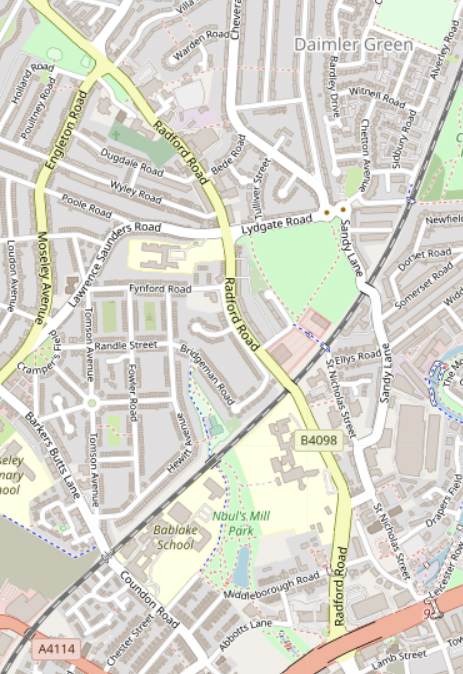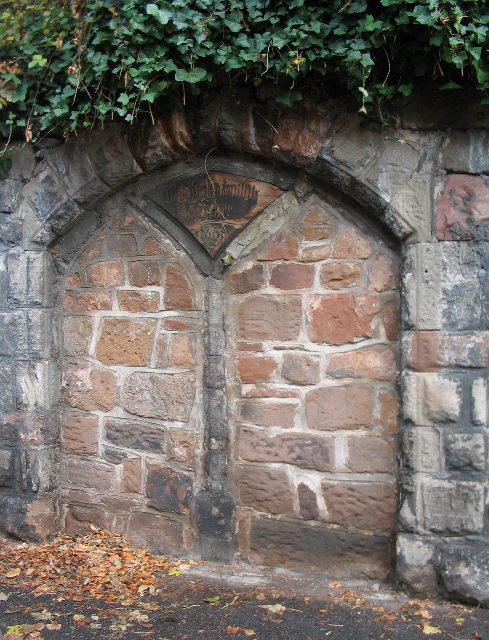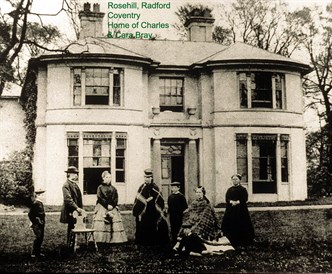
Today we have the eighteenth episode of Peter Walter’s series of lockdown walks “being a compendium of idle facts, hidden places and meaningless historiana gathered on walks within easy striding distance of the writer’s abode – and beyond”.
The words Middleborough Terrace 1851, in gothic script, are still just visible in a blocked-up arch on the sandstone wall that runs along St Columba’s Close.

The mid-Victorian terrace of substantial villas behind the wall is long gone, replaced by the intimidating bulk of Samuel Vale House, and somewhere beneath lie traces of the original St Nicholas Church, first recorded in the twelfth century and once believed to be where Coventry began. The past is a bit like that in this part of Radford. It comes and it goes without much ceremony.
St Columba’s Close, the only street with that name in the country, apparently, was itself once an elegant stretch of the main road into the city centre, until mercilessly cut off in the 1960s by a new road torn out of the hillside to link up with that destroyer of worlds, the Ring Road.
Further along the Radford Road, Barr’s Hill House, home to the bicycling Starleys, saviours of Coventry when that terrace of villas was quite new, has gone too. But at least here it’s the future, not the past, that’s worth considering. Barr’s Hill School, which hugs the hillside site now, is currently in the top two per cent of schools when it comes to progress made by pupils.
No such consolation is available for the site of Rosehill, home to George Eliot’s mentor, Charles Bray and a place, the writer recalled many years later, where she and the Brays would take tea and intellectual conversation on summer lawns. Now it’s an anonymous construction site, with something very big rising fast.

Mary Anne Evans, as she still was, was also fond of arm-in-arm walks with Cara Bray along the ridge over what is now Radford Recreation Ground. Unromantic as it sounds, the ‘rec’ can still boast charming green views in every direction and is flanked by some of the city’s most palatial municipal housing, built for the new Radford garden suburb, as it began to emerge in the mid-1920s.
The second St Nicholas Church was already there to serve that fast expanding city suburb, but it too has gone now, blown to pieces by a landmine in the November 1940 blitz. Beneath the velvet lawns of its beautifully-kept churchyard rest an intriguing roll-call of characters; titans of the car and bicycle industries like William Riley, Henry Sturmey and Charles Vernon Pugh, Victorian naturalist John George Wood, who died in Coventry on a lecture tour at the end of the 1880s and, most unexpected, England cricketer Andrew Stoddart, who opened the batting with WG Grace and captained his country at both cricket and rugby.

Just beyond the churchyard, St Nicholas Church number three stands boarded up and abandoned, looking a bit like a nineteenth century prison hulk. But it’s not the end of life that’s of interest here. At No.2 Poultney Road, in August 1922, the wife of Coventry’s new deputy city treasurer gave birth to a son. Philip Larkin’s birthplace was adorned with nightmarish fake stone cladding last time I looked, but that’s now been ripped off. He’d be relieved to see that.

